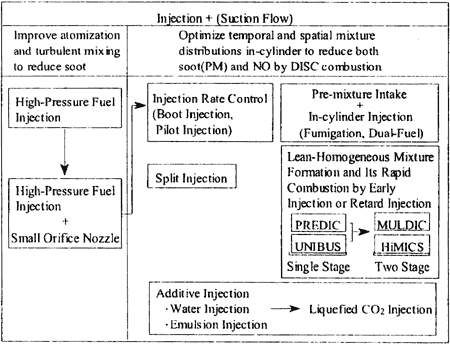TS-78
Low Emission Diesel with Combustion System by Use of Reformulated Fuel Liquefied C02 and n-Tridecane
Jiro Senda*, Shigeyuki Oshita**, Masaaki Yamamoto**, and Hajime Fujimoto***
ABSTRACT
We propose a new concept on simultaneous reduction of NO and soot emissions in Diesel engine exhaust by use of the diesel fuel oil (n-Tridecane) with liquefied CO2 dissolved. The CO2 dissolved component is expected to undergo flash boiling or gas separation when being injected into the combustion chamber, and improve spray atomization and mixing process both of which are primary factors to govern soot formation. Further, the internal EGR effect caused by CO2 component injected with the fuel is expected for NO formation. In order to assess this concept, spray dynamics measurement was conducted in the constant volume vessel with a variation of ambient pressure and temperature. Further, combustion experiments were carried out by using a rapid compression and expansion machine, Here, characteristics of the evaporative mixed fuel spray were examined by shadowgraph photography. And flame characteristics were measured by direct photography to assess the qualitative flame temperature and soot concentration. From the results, it is revealed that the Diesel fuel - liquefied CO2 mixed fuel can successfully reduce NO and soot emissions in Diesel combustion process with keeping and improving the combustion coefficient.
Key Words: Fuel Design, Flash Boiling, Diesel Engine, Low Emission Combustion, Spray Atomization
1. INTRODUCTION
In Diesel Engines, the trade-off relation for reducting both soot (Particulate Matter) and NO emissions can not be avoided. Thus, the way to reduce soot or PM is contrary to the reduction of NO in Diesel combustion process. Accordingly, several combustion system concerning with the injection system are proposed to reduce exhaust emission with keeping the thermal efficiency in recent years as shown in Fig. 1. As a background of this study, the recent attempts in Diesel fuel injection systems are summarized here.
High-pressure fuel injection system has been applied to the actual production engines to drastically reduce soot emission. Furthermore, the system was experimented with retarded injection timing in order to reduce NO emission, also small orifice nozzle was applied to high-pressure injection system to effectively reduce soot emission and to control the NO formation by forming the relative homogeneous lean mixture inside the chamber. However, NO was not decreased well even in the case of micro-hole nozzle injection. Since the fuel rich mixture near the stoichiometric equivalent ratio must be unavoidably formed locally with this in-cylinder injection just before TDC timing. Recently, the new combustion system by use of carly stage in-cylinder injection has been proposed. In this system, they intend to realize the rapid burning of the lean-homogeneous mixture prepared in the cylinder with early stage fuel injection. Thus, NO emission is decreased remarkably as a level of one tenth with comparing to the previous combustion system with keeping low soot emission in the condition of light load (air excess ratio λ >2.5). However, CO and HC emission increase and the load range for NO reduction is limited as λ >2.5, in this system. Thus, this single stage lean-homogeneous mixture combustion system could not generally provide low NO emission in practical high load conditions as mentioned later.

Fig. 1 New attemps in Deisel fuel injection system for exhaust emission reduce
* Professor Dept. of Mechanical Engineering, Doshisha Univ., Kyotanabe, 610-0321 Kyoto, Japan
e-mail : jsenda@mail.doshisha.ac.jp
** Graduate Student, Doshisha Univ.
*** Professor, Dept, of Mechanical Engineering, Doshisha Univ.
BACK CONTENTS NEXT